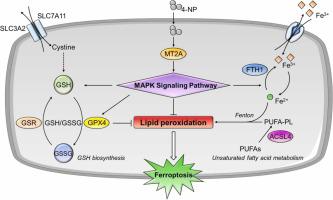当前位置:
X-MOL 学术
›
J. Hazard. Mater.
›
论文详情
Our official English website, www.x-mol.net, welcomes your
feedback! (Note: you will need to create a separate account there.)
Long-term 4-nonylphenol exposure drives cervical cell malignancy through MAPK-mediated ferroptosis inhibition
Journal of Hazardous Materials ( IF 12.2 ) Pub Date : 2024-04-21 , DOI: 10.1016/j.jhazmat.2024.134371 Xing Zhang 1 , Wenjing Yan 1 , Xue Chen 1 , Xiuting Li 2 , Bingjia Yu 2 , Yan Zhang 3 , Bo Ding 4 , Jing Hu 1 , Haohan Liu 1 , Yamei Nie 1 , Fengying Liu 1 , Yun Zheng 1 , Yiran Lu 1 , Jin Wang 1 , Shizhi Wang 1
Journal of Hazardous Materials ( IF 12.2 ) Pub Date : 2024-04-21 , DOI: 10.1016/j.jhazmat.2024.134371 Xing Zhang 1 , Wenjing Yan 1 , Xue Chen 1 , Xiuting Li 2 , Bingjia Yu 2 , Yan Zhang 3 , Bo Ding 4 , Jing Hu 1 , Haohan Liu 1 , Yamei Nie 1 , Fengying Liu 1 , Yun Zheng 1 , Yiran Lu 1 , Jin Wang 1 , Shizhi Wang 1
Affiliation

|
4-NP (4-nonylphenol), a prevalent environmental endocrine disruptor with estrogenic properties, is commonly detected in drinking water and food sources. It poses a significant risk of endocrine disruption, thereby influencing the onset and progression of diverse diseases, including tumorigenesis. However, its specific impact on cervical cancer remains to be fully elucidated. Our study focused on the biological effects of sustained exposure to low-dose 4-NP on human normal cervical epithelial cells (HcerEpic). After a continuous 30-week exposure to 4-NP, the treated cells exhibited a significant malignant transformation, whereas the solvent control group showed limited malignant phenotypes. Subsequent analyses of the metabolomic profiles of the transformed cells unveiled marked irregularities in glutathione metabolism and unsaturated fatty acid metabolism. Analyses of transcriptomic profiles revealed significant activation of the MAPK signaling pathway and suppression of ferroptosis processes in these cells. Furthermore, the expression of MT2A was significantly upregulated following 4-NP exposure. Knockdown of MT2A restored the aberrant activation of the MAPK signaling pathway, elevated antioxidant capacity, ferroptosis inhibition, and ultimately the development of malignant phenotypes that induced by 4-NP in the transformed cells. Mechanistically, MT2A increased cellular antioxidant capabilities and facilitated the removal of toxic iron ions by enhancing the phosphorylation of ERK1/2 and JNK MAPK pathways. The administration of activators and inhibitors of the MAPK pathway confirmed that the MAPK pathway mediated the 4-NP-induced suppression of ferroptosis and, ultimately, the malignant transformation of cervical epithelial cells. Overall, our findings elucidated a dynamic molecular transformation induced by prolonged exposure to 4-NP, and delineated comprehensive biological perspectives underlying 4-NP-induced cervical carcinogenesis. This offers novel theoretical underpinnings for the assessment of the carcinogenic risks associated with 4-NP.
中文翻译:

长期接触 4-壬基酚通过 MAPK 介导的铁死亡抑制导致宫颈细胞恶性肿瘤
4-NP(4-壬基酚)是一种常见的环境内分泌干扰物,具有雌激素特性,通常在饮用水和食物来源中检测到。它具有内分泌干扰的重大风险,从而影响多种疾病的发生和进展,包括肿瘤的发生。然而,其对宫颈癌的具体影响仍有待充分阐明。我们的研究重点是持续暴露于低剂量 4-NP 对人类正常宫颈上皮细胞 (HcerEpic) 的生物学效应。连续暴露于4-NP 30周后,处理的细胞表现出明显的恶性转化,而溶剂对照组表现出有限的恶性表型。随后对转化细胞的代谢组学特征的分析揭示了谷胱甘肽代谢和不饱和脂肪酸代谢的明显不规则性。转录组图谱分析揭示了这些细胞中 MAPK 信号通路的显着激活和铁死亡过程的抑制。此外,暴露于 4-NP 后,MT2A 的表达显着上调。 MT2A 的敲低恢复了 MAPK 信号通路的异常激活、抗氧化能力提高、铁死亡抑制,并最终导致转化细胞中 4-NP 诱导的恶性表型的发展。从机制上讲,MT2A 通过增强 ERK1/2 和 JNK MAPK 通路的磷酸化来提高细胞抗氧化能力并促进有毒铁离子的去除。 MAPK 通路激活剂和抑制剂的施用证实,MAPK 通路介导 4-NP 诱导的铁死亡抑制,并最终介导宫颈上皮细胞的恶性转化。 总体而言,我们的研究结果阐明了长期暴露于 4-NP 诱导的动态分子转化,并描绘了 4-NP 诱导宫颈癌发生的综合生物学观点。这为评估 4-NP 相关的致癌风险提供了新的理论基础。
更新日期:2024-04-21
中文翻译:

长期接触 4-壬基酚通过 MAPK 介导的铁死亡抑制导致宫颈细胞恶性肿瘤
4-NP(4-壬基酚)是一种常见的环境内分泌干扰物,具有雌激素特性,通常在饮用水和食物来源中检测到。它具有内分泌干扰的重大风险,从而影响多种疾病的发生和进展,包括肿瘤的发生。然而,其对宫颈癌的具体影响仍有待充分阐明。我们的研究重点是持续暴露于低剂量 4-NP 对人类正常宫颈上皮细胞 (HcerEpic) 的生物学效应。连续暴露于4-NP 30周后,处理的细胞表现出明显的恶性转化,而溶剂对照组表现出有限的恶性表型。随后对转化细胞的代谢组学特征的分析揭示了谷胱甘肽代谢和不饱和脂肪酸代谢的明显不规则性。转录组图谱分析揭示了这些细胞中 MAPK 信号通路的显着激活和铁死亡过程的抑制。此外,暴露于 4-NP 后,MT2A 的表达显着上调。 MT2A 的敲低恢复了 MAPK 信号通路的异常激活、抗氧化能力提高、铁死亡抑制,并最终导致转化细胞中 4-NP 诱导的恶性表型的发展。从机制上讲,MT2A 通过增强 ERK1/2 和 JNK MAPK 通路的磷酸化来提高细胞抗氧化能力并促进有毒铁离子的去除。 MAPK 通路激活剂和抑制剂的施用证实,MAPK 通路介导 4-NP 诱导的铁死亡抑制,并最终介导宫颈上皮细胞的恶性转化。 总体而言,我们的研究结果阐明了长期暴露于 4-NP 诱导的动态分子转化,并描绘了 4-NP 诱导宫颈癌发生的综合生物学观点。这为评估 4-NP 相关的致癌风险提供了新的理论基础。





















































 京公网安备 11010802027423号
京公网安备 11010802027423号